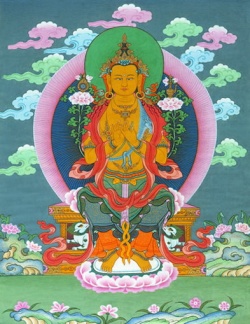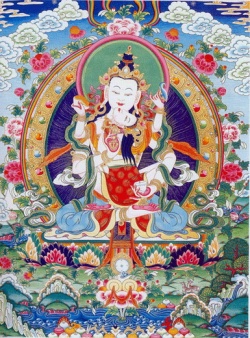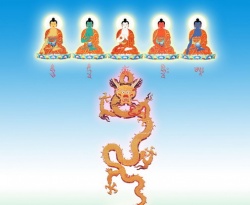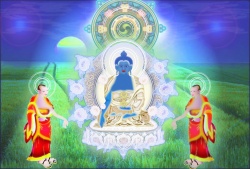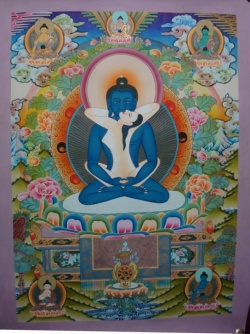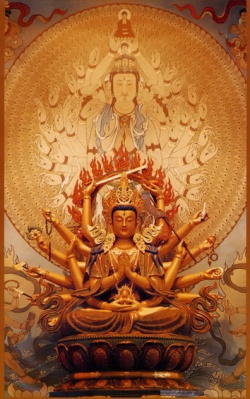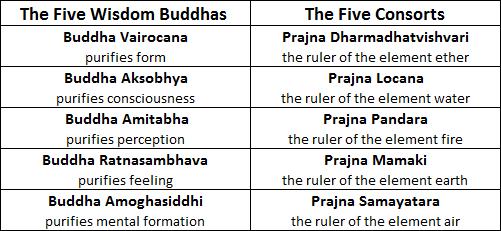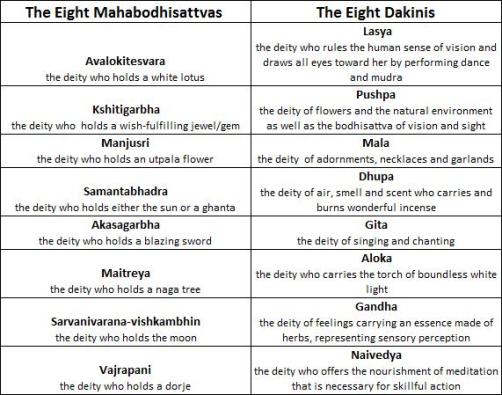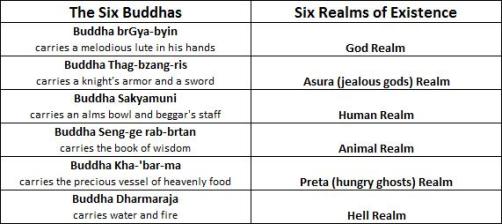Chonyid Bardo: The Vision Of The Peaceful Deities
The Chonyid Bardo is the second after-death state described in the Bardo Thodol (Tibetan Book of the Dead) where visual and auditory phenomena occur. After witnessing the Primordial Clear Light in the Chikhai Bardo, what follows is a progressive vision of the peaceful deities from the fivefold radiant light of the primordial Buddha on the fourth until the eleventh day.
Corresponding with the visions in this state is a feeling of intense tranquility and perfect knowledge. However, it is also said that the consciousness of the departed naturally go astray during this bardo experience if the necessary effort was not made during his or her lifetime to fully recognize the Primordial Clear Light. This means they get lost during the process and may end up some place they don’t like in their next rebirth.
What are the Deities of the Chonyid Bardo?
In Tibetan Buddhist doctrines, it is said that a concentration of five radiant lights emanate from the heart center of our spirit-body. It is from this center that the peaceful deities emerge. These deities occupy a very special position in the long line of buddhas and bodhisattvas. They constitute many philosophical and religious teachings and serve as guiding symbols for the spiritual life.
The deities that emerge in the Chonyid Bardo are said to be the manifestations of the karmic fruits and experiences in one’s life. They are the fusion of joy and emptiness, which comes from the realm of pure self-awareness. These apparitions may either be mesmerizing or frightening in appearance.
The deities in the Chonyid Bardo can be invoked by mantras that correspond to them. These mantras are considered to be the carriers of spiritual energy and channels for the wisdom of the Buddhas. Traditionally, they are only given from guru to disciple, which is why only those who know these mantras are able to communicate with the bardo deities.
What is the purpose of the Chonyid Bardo experience?
The purpose of the experience in the Chonyid Bardo is to help transform one’s consciousness via the dramatic display of psychic projections to purge one’s excessive karmic content. This is essentially the same thing that takes place when one reaches the deeper states during meditation. All the positive and negative emotional materials accumulated during one’s lifetime take their individual turn in coming to the surface of one's consciousness. This transformation is in some way analogous with the story wherein Christ meets the devil who offers him an easy life of self indulgence and illusions of power or when the Buddha meets Mara (the dark lord) who tempts him with beautiful women.
Vision of the Peaceful Deities (Day 4-11)
The vision of the peaceful and wrathful deities is said to take place from the 4th to 11th day of a person's death. The deities of the Chonyid Bardo are always depicted in a sitting, standing, or moving position on a lotus. They are surrounded by a powerful aura made of intense colors of the five elements. The lotus represents spiritual unfoldment and attainment. It also signifies that the deities have prevailed over the cycle of birth, life, death, and rebirth.
There are five groups of peaceful deities that belong to the first part of the Chonyid Bardo experience:
- The Five Wisdom Buddhas and their consorts
- The Eight Mahabodhisattvas and their Dakinis
- The Buddhas of the Six Realms of Existence
- The Four Male & The Four Female Guardians
- The Five Knowledge-Holding Deities
The second part of the Chonyid Bardo experience involves the same deities only this time turning into their wrathful counterparts (discussed in the next article).
Note: Due to the amount of time and space it would take to provide the details about the meaning of these deities and their other symbols, I decided to provide only a summary. I do think many of the symbols here and their meanings can be easily found on the web.
1. The Five Wisdom Buddhas and their consorts
The first and second day in the Chonyid Bardo involve the vision of the Five Wisdom Buddhas (or Five Tathagatas) in order to purify the Five Aggregates (Skandhas); these aggregates are form, consciousness, perception, feeling, and mental formation. On the other hand, the five female buddhas purify the five elemental realms and they are usually depicted in inseparable tantric union, called Yab-Yum, with the Five Wisdom Buddhas.
Above the Five Wisdom Buddhas, in the highest rank, you’ll see Adibuddha as the pure Dharmakaya (truth body) and as the source of all further manifestations. Adibuddha is the mystical father and medium of all the buddhas and bodhisattvas in the bardo. The vision of the Adibuddha actually belongs to the Chikhai Bardo, but since he is the creator of the mandala where all the other deities manifest, it is essential for his name to be mentioned here.
2. The Eight Mahabodhisattvas and their Dakinis
The third and fourth day within the Chonyid Bardo involves the vision of the Eight Mahabodhisattvas and their Dakinis for the purification of the eight functions of consciousness and their realms of activity. They generally appear in mandalas, together with the Five Wisdom Buddhas, as male-female pairs. The Eight Mahabodhisattvas rule over the eight kinds of awareness (the psychic organs of perception), and the Eight Dakinis are associated with the eight realms of operation of these kinds of awareness (the corresponding physical organs of perception).
3. The Buddhas of the Six Realms of Existence
The fifth day is the vision of the Six Incarnations of the great Bodhisattva Avalokitesvara. This is the only experience carried out in the plane of the emanation body or Nirmanakaya (see first article). The six vices, which cause people to be reborn repeatedly due to karma, are said to be overcome with this experience. The six Buddhas are contemplated in detail in separate images during the death ritual so that the dead person in the bardo can realize early why these Buddhas appear as incarnations of Avalokitesvara in the Six Realms of Existence.
According to Buddhist belief, as long as human life is attached to the world of suffering due to ignorance, hatred, and desire, liberation from the chains of rebirth in the Six Realms of Existence is impossible. In order to communicate this fundamental knowledge to all six kinds of beings, Avalokitesvara appears in the Worlds of Existence in the form of the six Buddhas.
4. The Four Male & The Four Female Guardians
The sixth day is the vision of the four male and the four female Guardians of the Mandala, who each possess the third eye of higher knowledge and who help the dead person to attain the Four Sublime States. Like all the other deities of the Chonyid Bardo, they appear in tantric union with their female counterparts. They appear human but show wrathful faces, have bad haircuts, and wear crowns of five skulls. They guard the four cosmic directions of the mandala and at the same time become the guides of the consciousness of the dead in the transcendent world.
5. The Five Knowledge-Holding Deities
The seventh day is the vision of the Five Knowledge-Holding Deities or Vidhadharas. They are the last of the peaceful deities to appear and they occupy a special place in the mandala of deities. The Five Knowledge-Holding Deities form a mandala or circle in the throat chakra which represents the spiritually enlightened verbal sphere of human activity. Because of this, they neither belong to the spiritual plane of the peaceful deities which is the heart chakra nor to the mental plane of the wrathful deities which is the third eye chakra. Their position is special because no particular initiatory rite is associated with them. It could be that the knowledge of the mantras and the ritual process involved in this stage is a closely held secret among the Tibetans.
Illusory Images Of The Mind
One thing that is always mentioned in the Tibetan Book of the Dead is that these deities are not to be taken in the literal sense. No matter how extreme these figures may be, they are only projections of one’s unrecognized reality, i.e., the profound stuff that dwells in the subconscious. However, since they contain, as spiritual images, the most powerful forms of polarity and appear with such a convincing effect, you will find it impossible not to think that they are real. This is why the Tibetan Buddhists do not treat them as mere mythological figures.
- “The underlying problem of the Second Bardo is that any and every shape - human, divine, diabolical, heroic, evil, animal, thing - which the human brain conjures up or the past life recalls, can present itself to consciousness: shapes and forms and sounds whirling by endlessly. The underlying solution - repeated again and again - is to recognize that your brain is producing the visions. They do not exist. Nothing exists except as your consciousness gives it life. You are standing on the threshold of recognizing the truth: there is no reality behind any of the phenomena of the ego-loss state, save the illusions stored up in your own mind either as accretions from game (sangsaric) experience or as gifts from organic physical nature and its billion-year old past history. Recognition of this truth gives liberation.”
- — The Psychedelic Experience: A manual based on the Tibetan Book of the Dead, 1964)
The deities in the Chonyid Bardo are not “gods” as we know them. They do not occupy any temporal and spatial realm because their existence is so incredibly different from the reality of the physical world. Thus, if you want to find out who or what these deities really are, you would have to spend years and years of dedicated practice in meditation. However, if you want to take a shortcut, you do have the option to take psychedelics. Just keep in mind that you are most likely to meet the wrathful deities first if you don’t know what you’re doing.
